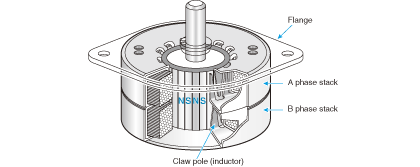2-4-2. Claw Pole Type PM Motor
A variation of the hybrid type is the claw-pole type PM motor.
It seems that many of the so-called PM (permanent magnet) motors refer to this claw-pole type.
Fig. 2.56 shows the structure of this motor. The motor stator is configured with two sets of a ring coil and a tooth made by sheet-metal processing.
The claw portion of the steel plate is called the claw pole, claw tooth, or inductor.
The top and bottom claws for sandwiching the coil are arranged to fit into each other.
When the coil is energized, the inductor is magnetized to the N-pole, then to the S-pole, then to the N-pole, and then to the S-pole.
A typical claw-pole type PM motor has 24 inductors (claw pole) in each of phases A and B. Bi-filer winding is generally employed for the coil.

A ferrite magnet or rare earth magnet magnetized at the same pitch as that of the inductors is used for the rotor.
If magnets are aligned straight across both phases A and B, phases A and B are shifted from each other by a 1/4-tooth pitch.
People did not pay much attention to the claw-pole type when it was first introduced. However, it began to enter more widespread use in the late 1970's when positioning precision was enhanced by the advancement of sheet metal processing technology.
Although it is difficult to reduce the step angle of this type of motor, they are now used in various sectors including PCs, printers, and home appliances thanks to their low production costs.
<Short column> Inductor
A claw pole is sometimes called an inductor. Roughly speaking, the inductor refers to an object that has a structure that creates the magnetic poles of NSNS. A motor equipped with a claw pole may also be called an "inductor motor". In such a case, please be careful not to mix up an inductor motor with an induction motor.

